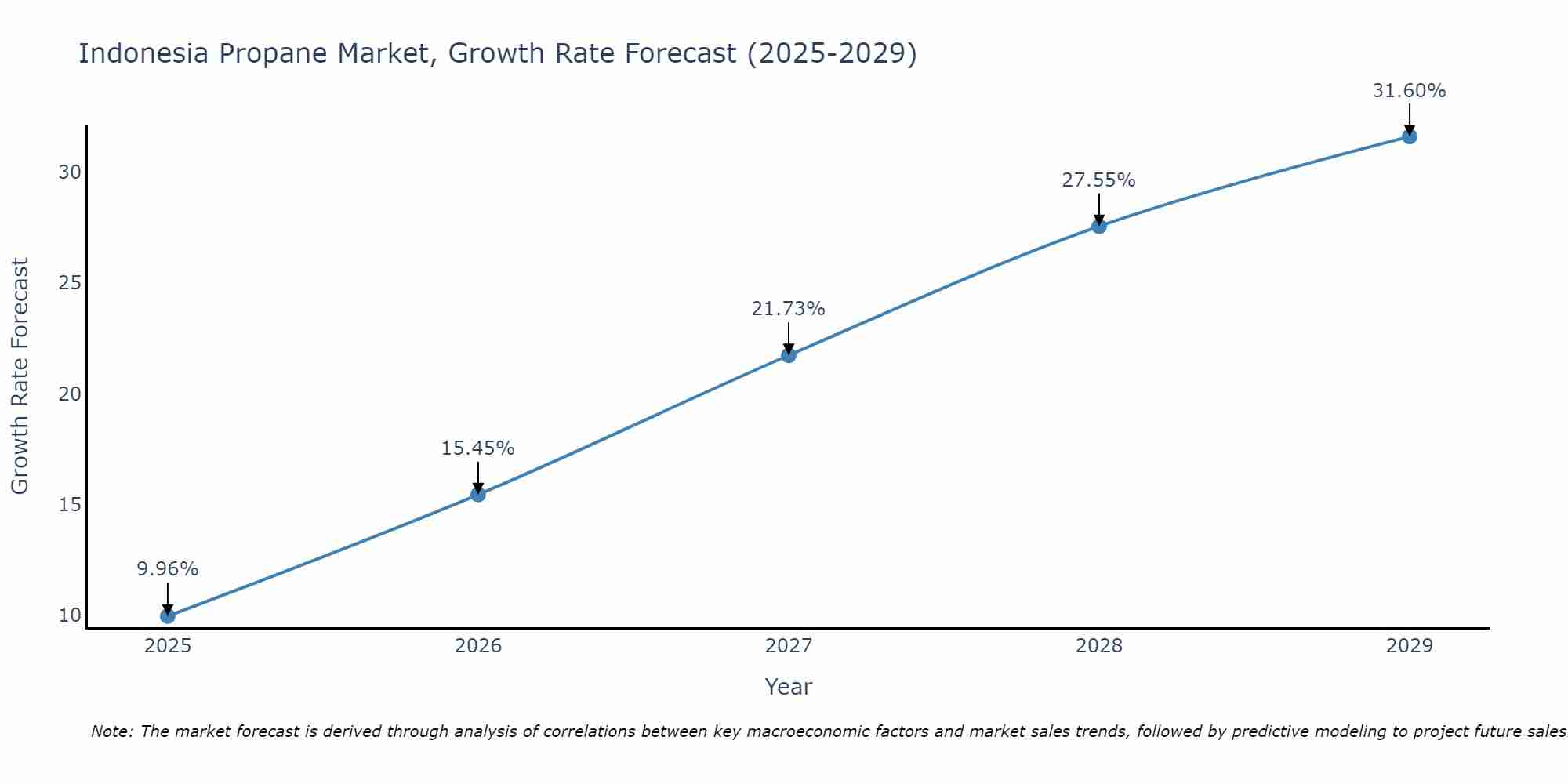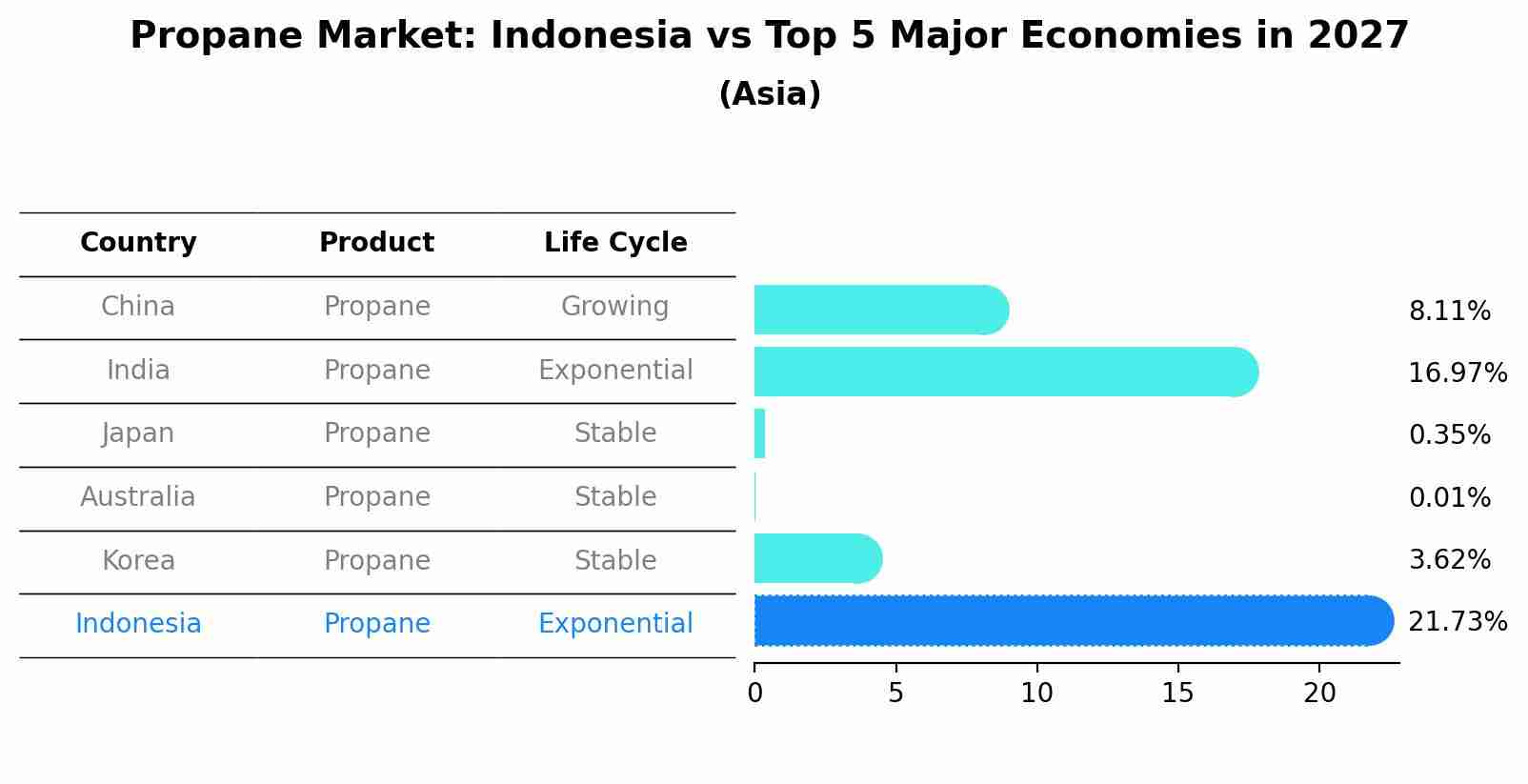Indonesia Propane Market (2025-2031) Outlook | Companies, Growth, Revenue, Trends, Analysis, Value, Forecast, Share, Industry & Size
| Product Code: ETC088487 | Publication Date: Jul 2023 | Updated Date: Apr 2025 | Product Type: Report | |
| Publisher: 6Wresearch | No. of Pages: 70 | No. of Figures: 35 | No. of Tables: 5 | |
Indonesia Propane Market Size Growth Rate
The Indonesia Propane Market is likely to experience consistent growth rate gains over the period 2025 to 2029. From 9.96% in 2025, the growth rate steadily ascends to 31.60% in 2029.

Propane Market: Indonesia vs Top 5 Major Economies in 2027 (Asia)
By 2027, the Propane market in Indonesia is anticipated to reach a growth rate of 21.73%, as part of an increasingly competitive Asia region, where China remains at the forefront, supported by India, Japan, Australia and South Korea, driving innovations and market adoption across sectors.

Indonesia Propane MarketSynopsis
Indonesia propane market is one of the fastest-growing markets in Southeast Asia. The market has seen a steady growth rate over the last few years, and this trend is likely to continue in the near future. The growing demand for clean energy sources, especially from industrial sectors, has been driving the Indonesia propane market for some time now. In addition, government initiatives such as tax incentives and subsidies have encouraged investments in alternative fuels like propane.
Market Trends
The trends observed in Indonesia propane industry include rising demand from residential consumers as well as an increased focus on safety measures due to stringent regulations enforced by local authorities. Additionally, there has been a rise in investment towards developing infrastructure related to storage and distribution networks of liquefied petroleum gas (LPG). This development can be attributed to increased awareness among both producers and end users about its benefits compared to other forms of fuel such as kerosene or diesel.
Market Drivers
The primary drivers behind Indonesia increasing demand for LPG are population growth and urbanization along with significant campaigns undertaken by the government that promote LPG usage within households rather than traditional cooking methods like wood burning stoves which release large amounts of smoke into the atmosphere contributing negatively towards air pollution levels across cities & towns throughout Indonesia. Other factors that contribute significantly towards this sector are subsidized prices set up by state-run oil companies encouraging greater penetration even amongst lower income households while also providing efficient delivery systems across major towns & villages located throughout country island spread geography adding further impetus for adoption amongst people living in rural regions where access to power grids may not be available or reliable at all times.
COVID-19 Impact on the Market
In light of recent developments concerning COVID-19 pandemic, Indonesia Propane industry was slightly affected due to restrictions imposed on transportation which hampered deliveries while reduced availability caused temporary disruption during March & April months although majority operations returned back normalcy post relaxation period post May 2025. Consumers adapted themselves very quickly though adopting online ordering options provided large scale distributors through apps ensuring continuation needs could still be met without risk exposure.
Challenges of the Market
Despite tremendous efforts put forward by Government, Regional Authorities & Industry Stakeholders alike ; challenges remain including lack of proper infrastructure related issues resulting low accessibility areas impeding supply chain processes thus leading high costs associated with logistics. Furthermore difficulties arise when regarding regulatory framework since implementation procedures differ depending upon region causing compliance complexities difficulting overall business execution process throughout.
Industry Key Players
Pertamina, Energy Logistics Indonesia, PT Lintas Raya Utama, PT Sarana Gas Cemerlang, Indoguna Group, PT Mitra Usaha Mandiri Niaga (MUMN), Enviroenergi Prima Sejahtera, The Linde Group, Subur Jaya Energi Nusantara (SJEN), PT Cahaya Abadi Gasindo.
Key Highlights of the Report:
- Indonesia Propane Market Outlook
- Market Size of Indonesia Propane Market, 2024
- Forecast of Indonesia Propane Market, 2031
- Historical Data and Forecast of Indonesia Propane Revenues & Volume for the Period 2021-2031
- Indonesia Propane Market Trend Evolution
- Indonesia Propane Market Drivers and Challenges
- Indonesia Propane Price Trends
- Indonesia Propane Porter's Five Forces
- Indonesia Propane Industry Life Cycle
- Historical Data and Forecast of Indonesia Propane Market Revenues & Volume By Applications for the Period 2021-2031
- Historical Data and Forecast of Indonesia Propane Market Revenues & Volume By Industrial for the Period 2021-2031
- Historical Data and Forecast of Indonesia Propane Market Revenues & Volume By Commercial for the Period 2021-2031
- Historical Data and Forecast of Indonesia Propane Market Revenues & Volume By Residential for the Period 2021-2031
- Historical Data and Forecast of Indonesia Propane Market Revenues & Volume By Transportation for the Period 2021-2031
- Historical Data and Forecast of Indonesia Propane Market Revenues & Volume By Agriculture for the Period 2021-2031
- Historical Data and Forecast of Indonesia Propane Market Revenues & Volume By Chemicals and Refineries for the Period 2021-2031
- Indonesia Propane Import Export Trade Statistics
- Market Opportunity Assessment By Applications
- Indonesia Propane Top Companies Market Share
- Indonesia Propane Competitive Benchmarking By Technical and Operational Parameters
- Indonesia Propane Company Profiles
- Indonesia Propane Key Strategic Recommendations
Frequently Asked Questions About the Market Study (FAQs):
1 Executive Summary |
2 Introduction |
2.1 Key Highlights of the Report |
2.2 Report Description |
2.3 Market Scope & Segmentation |
2.4 Research Methodology |
2.5 Assumptions |
3 Indonesia Propane Market Overview |
3.1 Indonesia Country Macro Economic Indicators |
3.2 Indonesia Propane Market Revenues & Volume, 2021 & 2031F |
3.3 Indonesia Propane Market - Industry Life Cycle |
3.4 Indonesia Propane Market - Porter's Five Forces |
3.5 Indonesia Propane Market Revenues & Volume Share, By Applications, 2021 & 2031F |
4 Indonesia Propane Market Dynamics |
4.1 Impact Analysis |
4.2 Market Drivers |
4.3 Market Restraints |
5 Indonesia Propane Market Trends |
6 Indonesia Propane Market, By Types |
6.1 Indonesia Propane Market, By Applications |
6.1.1 Overview and Analysis |
6.1.2 Indonesia Propane Market Revenues & Volume, By Applications, 2021-2031F |
6.1.3 Indonesia Propane Market Revenues & Volume, By Industrial, 2021-2031F |
6.1.4 Indonesia Propane Market Revenues & Volume, By Commercial, 2021-2031F |
6.1.5 Indonesia Propane Market Revenues & Volume, By Residential, 2021-2031F |
6.1.6 Indonesia Propane Market Revenues & Volume, By Transportation, 2021-2031F |
6.1.7 Indonesia Propane Market Revenues & Volume, By Agriculture, 2021-2031F |
6.1.8 Indonesia Propane Market Revenues & Volume, By Chemicals and Refineries, 2021-2031F |
7 Indonesia Propane Market Import-Export Trade Statistics |
7.1 Indonesia Propane Market Export to Major Countries |
7.2 Indonesia Propane Market Imports from Major Countries |
8 Indonesia Propane Market Key Performance Indicators |
9 Indonesia Propane Market - Opportunity Assessment |
9.1 Indonesia Propane Market Opportunity Assessment, By Applications, 2021 & 2031F |
10 Indonesia Propane Market - Competitive Landscape |
10.1 Indonesia Propane Market Revenue Share, By Companies, 2024 |
10.2 Indonesia Propane Market Competitive Benchmarking, By Operating and Technical Parameters |
11 Company Profiles |
12 Recommendations |
13 Disclaimer |
- Single User License$ 1,995
- Department License$ 2,400
- Site License$ 3,120
- Global License$ 3,795
Search
Related Reports
- Portugal Occupational Health & Safety Services Market (2025-2031) | Strategy, Consumer Insights, Analysis, Investment Trends, Opportunities, Growth, Size, Share, Industry, Revenue, Segments, Value, Segmentation, Supply, Forecast, Restraints, Outlook, Competition, Drivers, Trends, Demand, Pricing Analysis, Competitive, Strategic Insights, Companies, Challenges
- Netherlands Occupational Health and Safety Services Market (2025-2031) | Strategy, Consumer Insights, Analysis, Investment Trends, Opportunities, Growth, Size, Share, Industry, Revenue, Segments, Value, Segmentation, Supply, Forecast, Restraints, Outlook, Competition, Drivers, Trends, Demand, Pricing Analysis, Competitive, Strategic Insights, Companies, Challenges
- Belgium and Luxembourg Facility Management Market (2025-2031) | Strategy, Consumer Insights, Analysis, Investment Trends, Opportunities, Growth, Size, Share, Industry, Revenue, Segments, Value, Segmentation, Supply, Forecast, Restraints, Outlook, Competition, Drivers, Trends, Demand, Pricing Analysis, Competitive, Strategic Insights, Companies, Challenges
- Russia Women Intimate Apparel Market (2025-2031) | Strategy, Consumer Insights, Analysis, Investment Trends, Opportunities, Growth, Size, Share, Industry, Revenue, Segments, Value, Segmentation, Supply, Forecast, Restraints, Outlook, Competition, Drivers, Trends, Demand, Pricing Analysis, Competitive, Strategic Insights, Companies, Challenges
- Africa Chocolate Market (2025-2031) | Size, Share, Trends, Growth, Revenue, Analysis, Forecast, industry & Outlook
- Global Hydroxychloroquine And Chloroquine Market (2025-2031) | Industry, Trends, Size, Outlook, Growth, Value, Companies, Revenue, Analysis, Share, Forecast
- Saudi Arabia Plant Maintenance Market (2025-2031) | Industry, Size, Growth, Revenue, Value, Companies, Forecast, Analysis, Share & Trends
- Taiwan Electric Truck Market (2025-2031) | Outlook, Industry, Revenue, Size, Forecast, Growth, Analysis, Share, Companies, Value & Trends
- South Korea Electric Bus Market (2025-2031) | Outlook, Industry, Companies, Analysis, Size, Revenue, Value, Forecast, Trends, Growth & Share
- Africa Low Temperature Powder Coating Market (2025-2031) | Companies, Competition, Size, Challenges, Segmentation, Trends, Competitive, Industry, Supply, Strategy, Investment Trends, Growth, Segments, Restraints, Strategic Insights, Revenue, Share, Forecast, Drivers, Analysis, Pricing Analysis, Demand, Consumer Insights, Value, Opportunities, Outlook
Industry Events and Analyst Meet
Our Clients
Whitepaper
- Middle East & Africa Commercial Security Market Click here to view more.
- Middle East & Africa Fire Safety Systems & Equipment Market Click here to view more.
- GCC Drone Market Click here to view more.
- Middle East Lighting Fixture Market Click here to view more.
- GCC Physical & Perimeter Security Market Click here to view more.
6WResearch In News
- Doha a strategic location for EV manufacturing hub: IPA Qatar
- Demand for luxury TVs surging in the GCC, says Samsung
- Empowering Growth: The Thriving Journey of Bangladesh’s Cable Industry
- Demand for luxury TVs surging in the GCC, says Samsung
- Video call with a traditional healer? Once unthinkable, it’s now common in South Africa
- Intelligent Buildings To Smooth GCC’s Path To Net Zero













